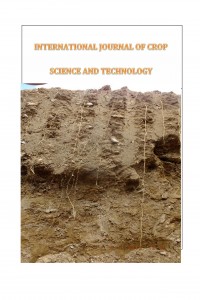Abstract
Tomato (Lycopersicon esculentum Mill.) is one of the most widespread vegetable crops for multiple uses in the diet of the human population. Tomato products and tomatoes are an important source of vitamin C, copper and iron, and contain significant amounts of B vitamins, and minerals such as potassium, sodium, magnesium and calcium. However, tomato lycopene seems particularly precious, active substances from the carotenoid family that plays an important role in the defense of the health of human organism.In the fruits of tomatoes lycopene is dominant carotenoid, and besides him there are also smaller facilities α-carotene, β-carotene, γ-carotene, phytoene, fitofluena, neurosporena and lutein. The content of lycopene in tomatoes is largely dependent on the different agro-ecological conditions, primarily temperature, solar radiation and humidity.It is clear that the variety, stage of maturity, different environmental conditions and production methods affect the chemical and physical characteristics of agricultural products. Bearing in mind the nutritional and halth importance of representation of tomatoes in the diet and the area in which this kind of vegetable products, the objective of this research is to examine the impact of different production systems (organic, integrated and conventional) on the synthesis and content of lycopene in tomatoes.All production systems include the established methodology that is used for the production of tomatoes in open field (block system). Within each type of production were included tomato hybrids Matias F1 and Sakura F1. The highest content of lycopene was recorded in the integrated production(6.05mg/100 g),and the lowestin conventional(5.88 mg/100g). The highest contentof lycopenehad ahybridSakuraF1from6.34to6.56 (mg/100g) depending on the mode of production
Keywords
References
- • Bramley, P. M. (2000): Is lycopene beneficial to human health? Phytochem. 54, 233 -236.
- • Burton, G. W., Ingold, K. U. (1984): β-carotene: an unusual type of lipid antioxidant. Science. 224, 569-573.
- • Dumas, Y., M. Dadomo, G. Di Lucca, and P.Grolier (2003):Effects of environmental fac-tors and agricultural techniques on antioxidant content of tomatoes. J. Sci. Food Agr. 83:369–382
- • Fraser PD, Bramley P, Seymour GB.(2001):Effect of the Cnr mutation on carotenoid formation during tomato fruit ripening. Phytochemistry58,75–79.
- • Gastélum-Barrios A, Bórquez-López R A, Rico-García E, Toledano-Ayala M, Soto-Zarazúa G M (2011): Tomato quality evaluation with image processing: A review. African Journal of Agricultural Research. 6 (14): 3333-3339.
- • Kapoulas N., Ilić Z.,Đurovka M., Radmila Trajković,LidijaMilenković(2011) : Effect of organic and conventional production practices on nutritional value and antioxidant activity of tomatoes. African Journal of Biotechnology Vol.10(71), pp. 15938-15945
- • Mencarelli, F. and M.E. Saltveit, Jr. (1988): Rip-ening of mature-green tomato fruit slices. J.Amer. Soc. Hort. Sci. 113:742-745Mitchell AE1, Hong YJ, Koh E, Barrett DM, Bryant DE, Denison RF, Kaffka S. (2007): Ten- of the influence of organic and conventional crop management practices on the content of flavonoids in tomatoes. Agric Food Chem. 55(15):6154-9.
- • Shi, J., Le Maguer, M. (2000): Lycopene in tomatoes: chemical and physical propoerties affected by food processing. Crit. Rev. Biotechnol., 20(4), 293-334.
- • Tan, B., & Soderstrom, D. N. (1988): Qualitative aspects of UV–VIS spectrophotometry of carotene and lycopene.Journal of Chemical Education, 22 , 21–31
Abstract
References
- • Bramley, P. M. (2000): Is lycopene beneficial to human health? Phytochem. 54, 233 -236.
- • Burton, G. W., Ingold, K. U. (1984): β-carotene: an unusual type of lipid antioxidant. Science. 224, 569-573.
- • Dumas, Y., M. Dadomo, G. Di Lucca, and P.Grolier (2003):Effects of environmental fac-tors and agricultural techniques on antioxidant content of tomatoes. J. Sci. Food Agr. 83:369–382
- • Fraser PD, Bramley P, Seymour GB.(2001):Effect of the Cnr mutation on carotenoid formation during tomato fruit ripening. Phytochemistry58,75–79.
- • Gastélum-Barrios A, Bórquez-López R A, Rico-García E, Toledano-Ayala M, Soto-Zarazúa G M (2011): Tomato quality evaluation with image processing: A review. African Journal of Agricultural Research. 6 (14): 3333-3339.
- • Kapoulas N., Ilić Z.,Đurovka M., Radmila Trajković,LidijaMilenković(2011) : Effect of organic and conventional production practices on nutritional value and antioxidant activity of tomatoes. African Journal of Biotechnology Vol.10(71), pp. 15938-15945
- • Mencarelli, F. and M.E. Saltveit, Jr. (1988): Rip-ening of mature-green tomato fruit slices. J.Amer. Soc. Hort. Sci. 113:742-745Mitchell AE1, Hong YJ, Koh E, Barrett DM, Bryant DE, Denison RF, Kaffka S. (2007): Ten- of the influence of organic and conventional crop management practices on the content of flavonoids in tomatoes. Agric Food Chem. 55(15):6154-9.
- • Shi, J., Le Maguer, M. (2000): Lycopene in tomatoes: chemical and physical propoerties affected by food processing. Crit. Rev. Biotechnol., 20(4), 293-334.
- • Tan, B., & Soderstrom, D. N. (1988): Qualitative aspects of UV–VIS spectrophotometry of carotene and lycopene.Journal of Chemical Education, 22 , 21–31
Details
| Primary Language | English |
|---|---|
| Journal Section | Makaleler |
| Authors | |
| Publication Date | November 26, 2015 |
| Published in Issue | Year 2015 Volume: 1 Issue: 2 |

